Historia Wczesnych Słoweńców
nadesłał Jarosław Ornicz
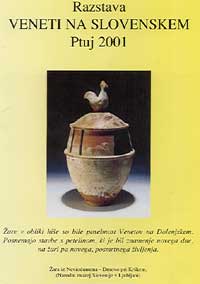
Concise History of Early Slovenians
to be read in conjunction with the brochure
Razstava na Ptuju by Rev. Ivan Tomažič
Zwięzła historia wczesnych Słoweńców do przeczytania w połączeniu z broszurą Razstava na Ptuju przez ks. Ivana Tomažiča
Most people educated in Slovenia over the last century have been told that Slovenians settled in Central Europe in the Sixth Century coming from behind the Carpathian Mountains. New evidence shows that, in fact, Slovenians are descendants of the indigenous people of Central Europe.
For those who wish to familiarize themselves with the basics of Slovenian history, the book VENETI: First Builders of European Community, written by Venetologist, Prof. Dr. Jožko Šavli, poet Matej Bor and Prof. Rev. Ivan Tomažič, is absolutely essential reading. Combining many decades of research, VENETI offers a careful study of facts essential to the understanding of the Slovenian past.
The 6th Century settlement theory implies that Slovenians moved within one generation from mud huts to the founding of their state of Carantania, and totally eradicated the language of the area’s „original population”. This theory is simply not logical or credible. The extract below is a concise account that there is much more to Slovenian history than was previously believed, followed be illustrated evidence.
Carantha http://www.niagara.com/~jezovnik is a treasure for history buffs where you can also order the book Veneti: First Builders of European Community.
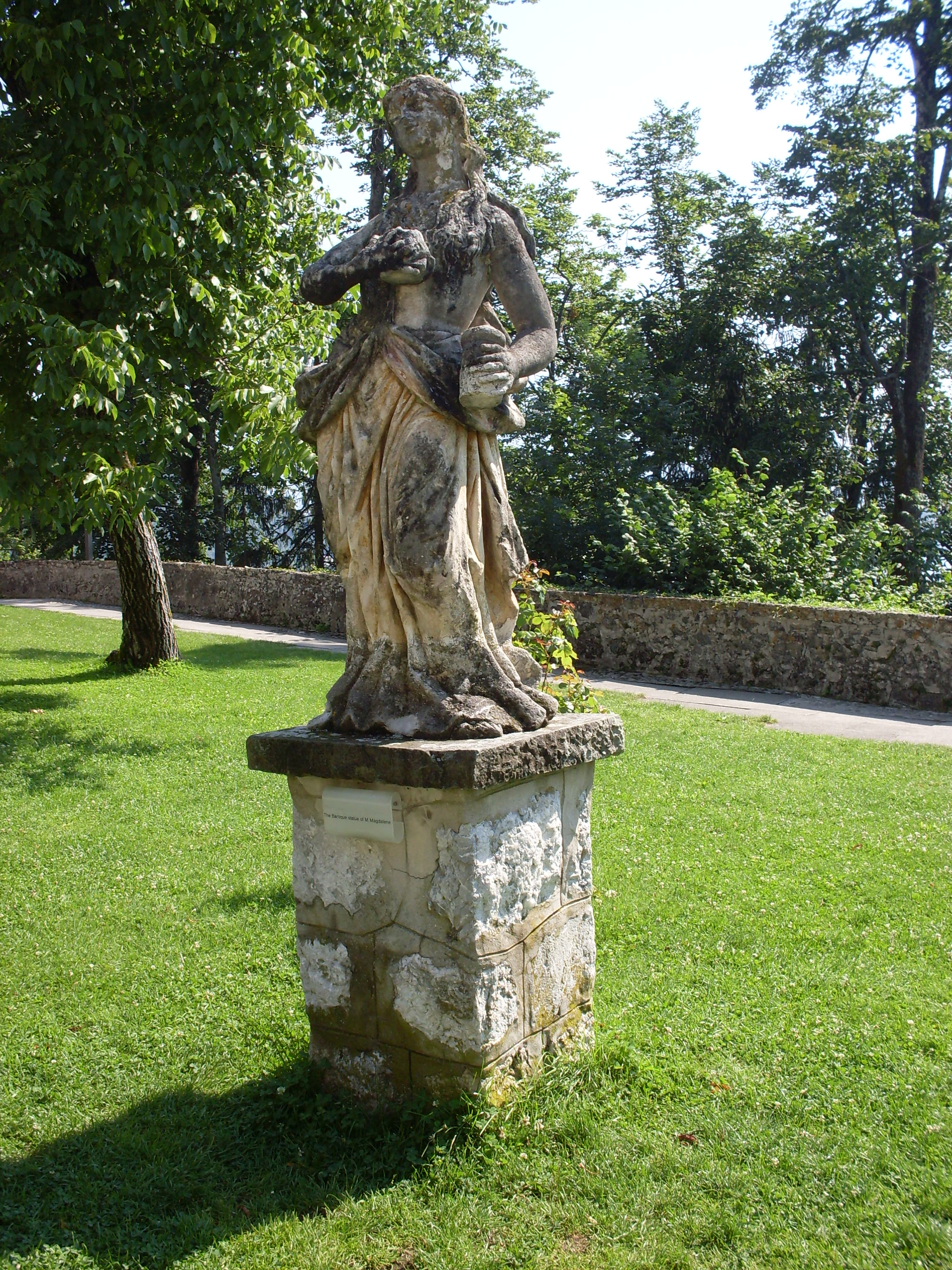
Nove Mesto – foto Jarosław Ornicz
Większość ludzi wykształconych w Słowenii w ciągu ostatniego stulecia otrzymało informację, że Słoweńcy osiedlili się w Europie Środkowej w VI wieku, pochodząc zza Karpat. Nowe dowody wskazują, że w rzeczywistości Słoweńcy są potomkami rdzennej ludności Europy Środkowej.

Nove Mesto – Świętowit – foto Jarosław Ornicz
Dla tych, którzy chcą zapoznać się z podstawami słoweńskiej historii, książka Wenedowie: Pierwsi budowniczowie Wspólnoty Europejskiej, napisana przez wenetologa, prof. Dr Jožko Šavli, poetę Mateja Bora i prof. Ks. Ivana Tomažiča, jest absolutnie niezbędną lekturą . Łącząc wiele dziesięcioleci badań, Wenedowie oferują dokładne przestudiowanie faktów niezbędnych do zrozumienia słoweńskiej przeszłości.
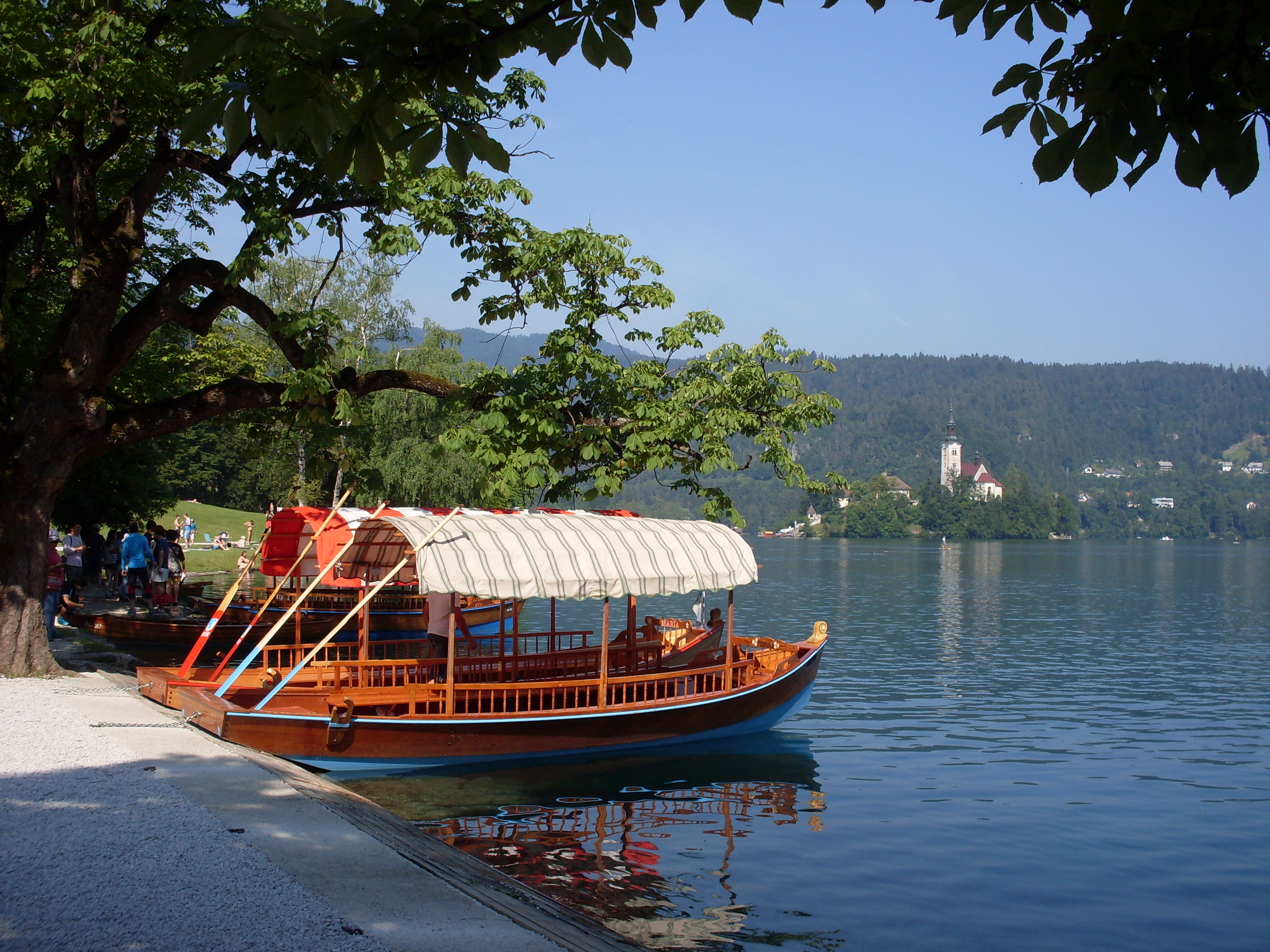
Jezioro Bled – foto Jarosław Ornicz
Teoria osadnictwa z VI wieku sugeruje, że Słoweńcy przenieśli się w ciągu jednego pokolenia od ziemianek do założenia swojego państwa Karnatania i całkowicie wyeliminowali język „pierwotnej populacji” tego obszaru. Teoria ta po prostu nie jest logiczna ani wiarygodna. Poniższy wyciąg jest zwięzłym opisem mówiącym, że historia Słowenii zawiera znacznie więcej niż wcześniej sądzono, a następnie daje zilustrowane dowody.

Jezioro Bled – wyspa na której znajdowała się świątynia bogini Żiwa – foto Jarosław Ornicz
Carantha http://www.niagara.com/~jezovnik to skarb dla miłośników historii, w którym można również zamówić książkę Veneti: Pierwsi budowniczowie Wspólnoty Europejskiej.
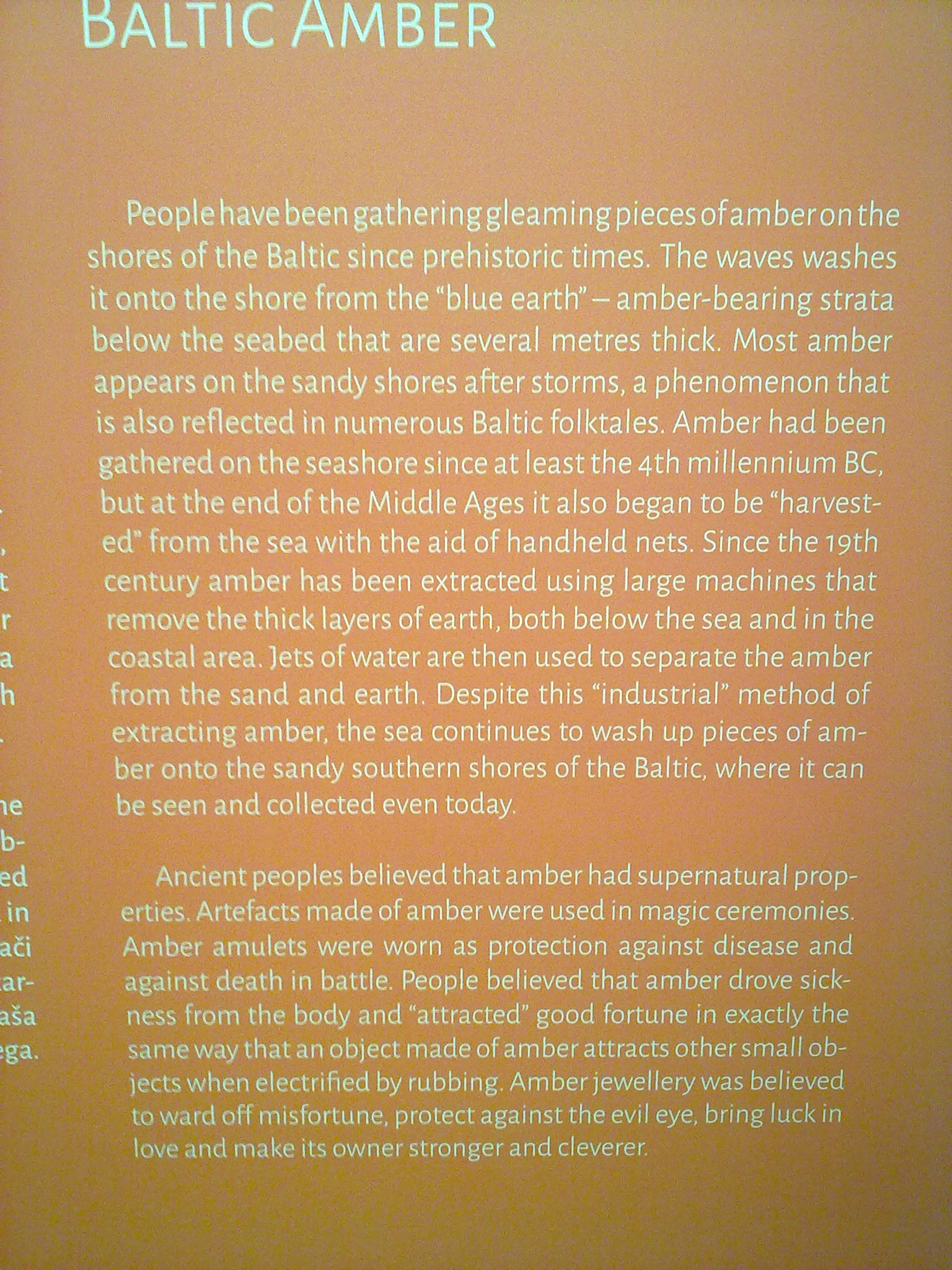
FIRST CENTURIES
The beginnings are in the Culture of Lužice
Science was not yet able to determine what language Europeans used before the Bronze Age and how Indo-European languages evolved. From the similarity between the Slovenian and Basque language, it could have only originated before the Indo-European Age, therefore we can assume, that the Indo-European language contained Slovenian Elements. With this assumption we can understand the beginnings of the Slovenian language in the form of the Indo-European languages within the then most important culture of Central Europe, namely in the culture of Lužice. Its language is known from the bearers of Urn Culture that has its origin in the Culture of Lužice. The people are called Veneti that is the same as Slo-Veneti. For this reason we can call their language Venetic, namely, Slovenetic or Slovenski that was spread by Veneti through culture where ever there are traces of the Slav language. And it is found everywhere in Europe especially in Central Europe. It is obvious that Veneti were especially prominent on today’s Slovenian territories, where they arrived on the well-known Amber Way (Jantarska pot). Here they developed a specific center. For this reason we can claim that Veneti are the ancestors of the Slovenian nation.
The Area of Culture at Lužice according to archeological findings.
***
Page 2
The Slovenian region before the settlement of Veneti
In the middle of the Bronze age, around 1200 B.C., when Veneti began to arrive in the present day Slovenia along the Amber Way from the territories occupied by Lužice Culture, the lands were sparsely populated, according to the archeological finds, as seen from the map bellow
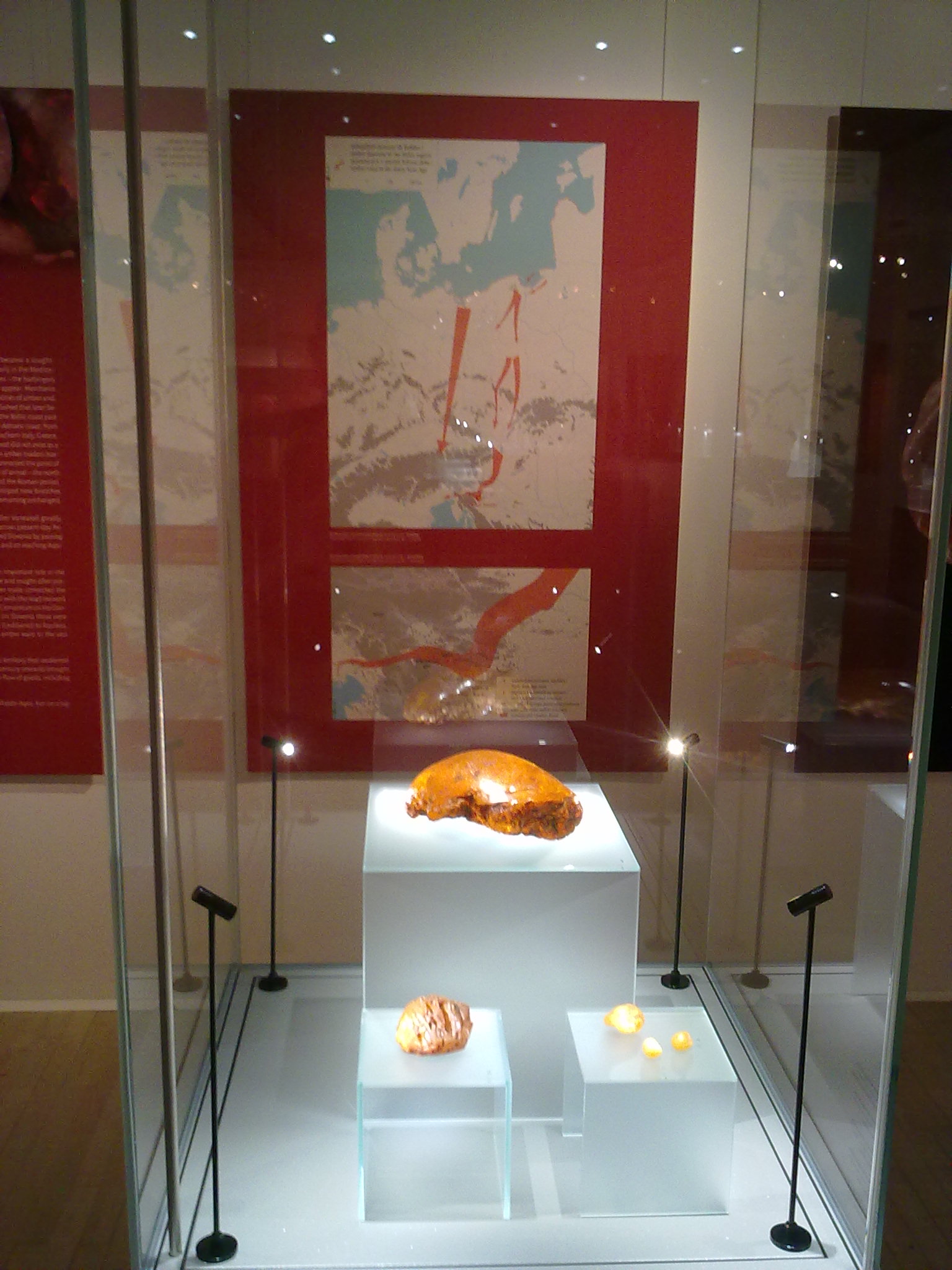
Wystawa w muzeum w Novym Mestie poświecona Szlakowi Bursztynowemu – foto Jarosław Ornicz
PIERWSZE WIEKI
Początki leżą w kulturze Łużyckiej
Nauka nie była jeszcze w stanie określić, jakiego języka używali Europejczycy przed epoką brązu i jak ewoluowały języki indoeuropejskie. Z podobieństwa między językiem słoweńskim i baskijskim mógł on powstać dopiero przed erą indoeuropejską, dlatego możemy założyć, że język indoeuropejski zawierał elementy słoweńskie. Przy takim założeniu możemy zrozumieć początki języka słoweńskiego w postaci języków indoeuropejskich w najważniejszej wówczas kulturze Europy Środkowej, a mianowicie w kulturze łużyckiej. Ten język znany jest od nosicieli kultury urn, która wywodzi się z kultury Łużyckiej. Ludzie nazywający się Wenedami, to to samo co Slo-Veneti. Z tego powodu możemy nazwać ich język wenetyjskim, a mianowicie słoweńskim lub słowiańskim, który został rozpowszechniony przez Wenedów poprzez kulturę, w której zawsze są ślady języka słowiańskiego. I znajduje się ona wszędzie w Europie, szczególnie w Europie Środkowej. Oczywiste jest, że Wenedowie byłi szczególnie widoczni na dzisiejszych słoweńskich terytoriach, gdzie dotarli znaną Bursztynową Drogą. Tutaj założyli konkretny ośrodek. Z tego powodu możemy twierdzić, że Wenedowie (Weneti, Wenetowie) są przodkami narodu słoweńskiego.
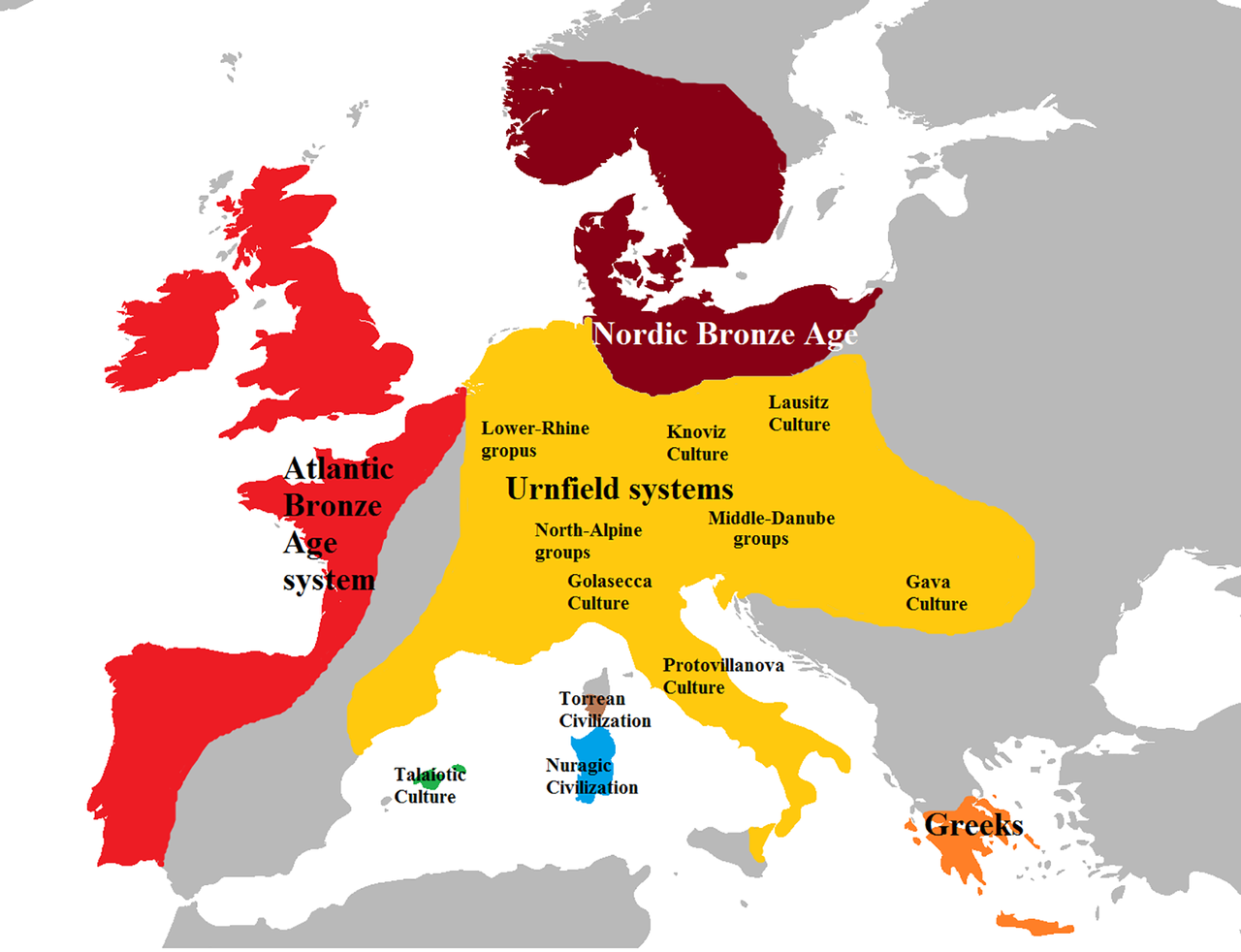
Obszar kultury Łużyckiej (Pół Popielnicowych) według znalezisk archeologicznych.
***
Strona 2
Region słoweński przed osadzeniem Wenedów
W połowie epoki brązu, około 1200 r p.n.e., kiedy Wenedzi zaczęli przybywać do dzisiejszej Słowenii wzdłuż Bursztynowej Drogi z terenów zajmowanych przez Kulturę Łużycką, ziemie były słabo zaludnione, zgodnie z znaleziskami archeologicznymi, jak widać z mapy poniżej
Slovenian territory was more or less always settled since the Paleolithic period. Many burial places testify to that especially Škocjanska jama, Potočka zijalka and Divje babe the location of the famous Neanderthal whistle find.
***
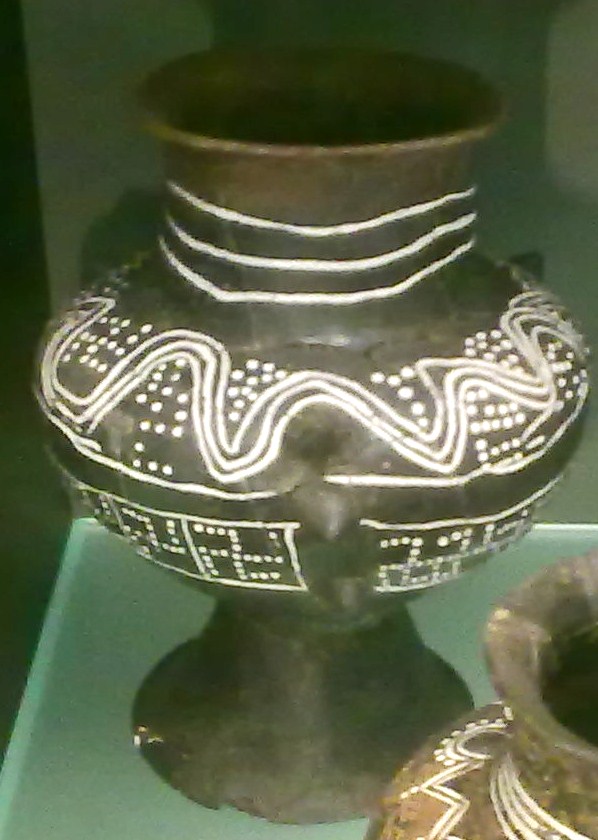
Wystawa w muzeum w Novym Mestie popielnica ze swastykami – foto Jarosław Ornicz
Page 3
Settlements some centuries after the arrival of Veneti
A considerable increase of the population on the Slovenian territory for some time after the arrival of Veneti testifies to their influx and permanent settlement. From the influence of the Culture of Urn Burials it is evident that Veneti did not want to dominate the other nations but wanted to spread their spiritual and material culture that brought people greater benefits.
yellow – settlements
green – burial grounds
From the map of the settlements and burial grounds it is possible to see that the territory of today’s Slovenia in the Antic and New Iron Age was tightly settled
(From the book ‚Zakladi tisočletij’
***

Wystawa w muzeum w Novym Mestie rekonstrukcja grobu skrzynkowego – foto Jarosław Ornicz
Page 4
The Method of Burial
Prior to the arrival of Veneti and for some time after, the dead were buried in heaped graves. The Veneti introduced cremation and this practice increased to becoming significant in religious practice. With the fire the deceased was not only relieved of all material burdens but also of all evil to make life after death possible. From the Venetic inscriptions we know that prayers accompanied cremation. The practice of Urn burial gives the name to the first culture of Veneti.
On the hill of Rabotnica to the south of Branik a large rock grave is located from the middle of the Bronze Age in which a wood-box with the remains of a deceased was found. In regard to the structure and the size of such graves, in Middle-Europe, they differ from others of that era and are very spars. Because they were placed on top of the Karst hills some archeologist assume that only selected members of the community were buried in them.
(From the book ‘Zakladi tisočletij’)
***

Jaskinia Skocziańska – foto Jarosław Ornicz
Page 5
The Beginning of the Slovenian Nation
From the Late Bronze Age a large number of burial sites on Slovenian territory, from Ruše near Maribor to Ljubljana and further to the Valley of Isonzo (Soča) testify of a predominantly new culture that began with the coming of Veneti. The Urnfield Culture was adopted by the original habitants of these territories and melded with Veneti into one ethnic community that formed the beginning of the Slovenian nation.
This was occurring between the 12th and the 10th Century B. C.
Terytorium słoweńskie było mniej więcej zawsze zasiedlane od okresu paleolitu. Wiele miejsc pochówków świadczy o tym, zwłaszcza Škocjanska jama, Potočka zijalka i Divje, gdzie znajduje się słynne znalezisko z gwizdkiem neandertalskim.
***
Strona 3
Osady kilka wieków po przybyciu Veneti
Znaczny wzrost liczby ludności na terytorium Słowenii przez pewien czas po przybyciu Wenedów świadczy o ich napływie i stałym osiedleniu. Z wpływu kultury pochówków w urnie widać, że Wenedowie nie chcieli dominować nad innymi narodami, ale chcieli szerzyć swoją duchową i materialną kulturę, która przyniosła ludziom większe korzyści.

żółty – osady
zielony – cmentarzyska
Z mapy osad i cmentarzysk można zobaczyć, że terytorium dzisiejszej Słowenii w epoce antycznej i nowej epoce żelaza było ściśle określone
(Z książki „Zakladi tisočletij”)
***
Strona 4
Metoda pochówku
Przed przybyciem Wenedów i przez pewien czas potem zmarłych chowano w grobowcach. Wenedowie wprowadzili kremację, a praktyka ta stała się znacząca w praktyce religijnej całej ludności. Ogień uwolniał zmarłego nie tylko od wszystkich materialnych obciążeń, ale także od wszelkiego zła, dając możliwość życia po śmioerci. Z wenedzkich inskrypcji wiemy, że modlitwy towarzyszyły kremacji. Praktyka pochówku w popielnicy (urnie) nadaje nazwę pierwszej kulturze Wenedzkiej (kultura pól popielnicowych).

Na wzgórzu Rabotnica na południe od Branika znajduje się duży grób skalny z połowy epoki brązu, w którym znaleziono skrzynię z pozostałościami zmarłego. Pod względem struktury i wielkości takich grobów różnią się one w Europie Środkowej od innych epok i są bardzo rzadkie. Ponieważ zostały umieszczone na wzgórzach krasowych, niektórzy archeolodzy zakładają, że zostali w nich pochowani tylko wybrani członkowie społeczności.
(Z książki „Zakladi tisočletij”)
***
Strona 5
Początek narodu słoweńskiego
Od późnej epoki brązu wiele miejsc pochówku na terytorium Słowenii, od Ruše koło Mariboru do Lublany i dalej do Doliny Isonzo (Soča), świadczy o przeważnie nowej kulturze, która rozpoczęła się wraz z przybyciem Wenedów. Kultura Pól Popielnicowych (Urnfield) została przyjęta przez pierwotnych mieszkańców tych terytoriów i zespolona z Wenedami w jedną wspólnotę etniczną, która stała się początkiem narodu słoweńskiego.
Miało to miejsce między 12. a 10. wiekiem B. C.
Urns from burial grounds on Mestne njive in Novo mesto from the 9th Century B.C.
(Dolenjski Museum in Novo Mesto)

Jaskinia Skocziańska – foto Jarosław Ornicz

Otoczenie Jaskini Skocziańskiej – foto Jarosław Ornicz
Page 6
Venetic and the Slovenian language
The similarity of Slovenian and the Sanskrit language is significant in establishing the connection with Venetic Urnfield Culture. The similarity is demonstrated in the book VEDA that remains unchanged since the arrival of Veneti by way of the Adriatic Sea and also in India around 1000 B.C. The title of the three books VEDA (the oldest of them being RIG-VEDA) is a modern Slovenian word. Likewise there are many other words that are the same in Sanskrit and Slovenian. There is also strong similarity in grammatical structure. Just to mention one example, the dual that is used in Slovenian, Sanskrit and also in the language of Lužice. (See the book ‘Slovenci – Kdo smo’ Page 26-29).
An example from the book Rig-Veda.
As it is written now in the Script of Nagari. Copying of the book over several thousand years has resulted in the loss of the original script.

Urny z cmentarzyska na Mestne njive w Novo mesto z IX wieku p.n.e.
(Muzeum Dolenjski w Novo Mesto)
Strona 6
Język wenecki i słoweński
Podobieństwo języka słoweńskiego i sanskrytu jest znaczące w ustanawianiu związku z kulturą Venetic Urnfield. Podobieństwo wykazano w książce VEDA, która pozostaje niezmieniona od przybycia Veneti przez Morze Adriatyckie, a także w Indiach około 1000 r.p.n.e. Tytuł trzech książek VEDA (najstarsza z nich to RIG-VEDA) to współczesne słoweńskie słowo. Podobnie jest wiele innych słów, które są takie same w sanskrycie i słoweńskim. Istnieje również silne podobieństwo w strukturze gramatycznej. Wystarczy wspomnieć o jednym przykładzie, podwójny, który jest używany w języku słoweńskim, sanskrycie, a także w języku Lužice. (Zobacz książkę „Slovenci – Kdo smo” str. 26–29).
Przykład z książki Rig-Veda.
Jak jest teraz napisane w Skrypcie Nagari. Kopiowanie książki przez kilka tysięcy lat spowodowało utratę oryginalnego skryptu.

Translation: I praise the brilliant God, the highest leader, the constant helper of the universe, the teacher of all the noble deeds, the only purpose of devotion at all times and the most indulgent one and the greatest giver of grandeur…
Tłumaczenie: Pochwalam genialnego Boga, najwyższego przywódcę, stałego pomocnika wszechświata, nauczyciela wszystkich szlachetnych czynów, jedynego celu oddania przez cały czas i najbardziej pobłażliwego i największego dawcy wielkości…
Page 7
The Venetic Script
The main proof that the Slovenian language developed from the language of Veneti are the ‚Venetic Inscriptions’ from 2500 years ago. They can still be understood, to some degree, only by using the bases of the Slovenian language. The Venetic Inscriptions were found not only in the region of Venice but also in Slovenia, from Idria near Bače and from Negova to Brumlje in Charintia.
One of the helmets from Ženjak near Negova with Venetic inscriptions.
Part of the helmet with the inscription
(Historical Art Museum in Vienna)
***
Page 8
The Proliferation of the Venetic Inscriptions
The Inscription on the helmet of Negova testify that the Venetic Culture with its language included the whole of Slovenian territory from Furlania to Panonia. This can be confirmed by the existence of the statue of the Soldier from Idria near Bače and its inscription being the same as on the helmet from Črnjak near Negova. The same type of helmet with similar inscriptions and in the same language was found in both places. A similar helmet was also found in Škocjanska jama (grotto).
| One of the helmets from Negova from the 5th Century B. C. Before it was laid into the grave with the deceased. It was probably marked with a battle-axe.
(Dolenjski Museum in Novo mesto) |
(The Museum of Natural Science in Vienna) |
***
Page 9
Slovenia – The Center of Slovenians
Slovenian territory is a geographically significant cross road in Central Europe. Archeological evidence from gravesites suggests that Veneti developed into successful traders, including trade with the Baltic countries. Amber was a major traded item from which they produced valuable jewelry.
Jewelry made from Baltic amber ) Dolenjski Museum in Novo mesto)
Jantarska pot (Amber Way) had its ending on the Slovenian territory
***
Page 10
Expanse of the Venetic Culture and Language
The significance of the Venetic center on Slovenian territory is confirmed with additional settlement on the adjoining regions especially in northern Italy and the Eastern Alps, where urnfields are found from a later period. The pass from Krajnske Alpe (Carniolan Alps) to Koroška (Carinthia) is marked by interesting inscriptions on a stone slab at Brumlje (Wurmlach) in Carinthia.
Translation: God (might have) gone to heaven here
One of the many inscriptions on the rock from Brumlje that is held in the Provincial Museum of Celovec (Klagenfurt).
A silver coin dating from the 3rd Century B.C. found at Most na Soči testifies of a connection between Veneti in Noric and in Soča Valley.
Page 11
Venetic art on Situlas
The uniqueness of Venetic Culture in Slovenia and Italy are the famous Situlas, art from the 6th to 4th Century B.C.
Situla is a small bucket with a handle, often decorated with scenes from everyday life or from nature. The decoration is produced by a beating technique and cutting into metal. Among many situlas, only the one from Škocjan caves has an inscription.
Two situlas from Novo mesto (Dolenjski Museum in Novo mesto)
***
Page 12
Situla from Vače
On the slope of a hill above Vače that is partly covered by forests, right up to the top, at Sv. Križ are many archeological sites from the times of our ancestors. This is where the famous Situla from Vače, that dates to the 5th Century B.C., was found.
(The National Museum of Slovenia, Ljubljana)
***
Page 13
A drawing of scenes in three bands on a village situla
One of the scenes on a village situla
(The National Museum of Slovenia in Ljubljana)
***
Page 14
THE IRON AGE
The beginning of the New Venetic Cultures
From the Venetic Urnfield Culture new cultures developed around the 8th Century B.C. On present day Slovenian territory the Hallstatt Culture and Este Culture are significant. Highly skilled work on the two-crested helmet from Vače and other similar art is attributed to the Hallstatt Culture even though it belongs to the continuation of the Venetic Culture with a specific phase of characteristics from the Iron Age that started in the 8th Century B.C. The continuation of urnfields testifies to the fact that there was no specific change or divide at that particular time.
The helmet from Vače dating to the 5th Century B.C. (The Museum of Natural Science in Vienna)
***
Strona 7
Pismo wenedzkie
Głównym dowodem na to, że język słoweński rozwinął się z języka Venedzkiego, są „Inskrypcje wenedzkie” sprzed 2500 lat. Nadal można je do pewnego stopnia zrozumieć tylko przy użyciu podstaw języka słoweńskiego. Inskrypcje wenedzkie znaleziono nie tylko w regionie Wenecji, ale także w Słowenii, od Idrii pod Bače i od Negovy po Brumlje w Karyntii.

Jeden z hełmów z Ženjak koło Negovy z inskrypcjami wenedzkimi.
Część hełmu z napisem
(Muzeum Sztuki Historycznej w Wiedniu)
***
Strona 8
Proliferacja wenedzkich napisów
Napis na hełmie z Negovy świadczy o tym, że kultura wenedzka z jej językiem obejmowała całe terytorium Słowenii od Furlanii po Panonię. Potwierdza to istnienie posągu Żołnierza z Idrii pod Bače, na którym napis jest taki sam jak na hełmie z Črnjaka koło Negovy. Ten sam rodzaj hełmu z podobnymi napisami w tym samym języku znaleziono w obu miejscach. Podobny hełm znaleziono również w Škocjanska jama (grota).
Jeden z hełmów z Negova z V wieku p.n.e. Przed złożeniem go do grobu ze zmarłym, prawdopodobnie był uderzony toporem bojowym.
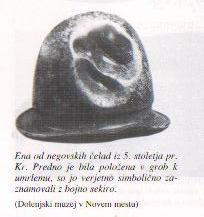 (Muzeum Dolenjski w Novo mesto)
(Muzeum Dolenjski w Novo mesto)

(Muzeum Przyrodnicze w Wiedniu)
***
Strona 9
Słowenia – Centrum Słoweńców
Terytorium Słowenii jest geograficznie znaczącym skrzyżowaniem w Europie Środkowej. Archeologiczne dowody z grobów sugerują, że Wenedzi rozwinęli się w odnoszących sukcesy kupców, w tym w utrzymujących handel z krajami bałtyckimi. Bursztyn był ważnym przedmiotem handlu, z którego wytwarzano cenną biżuterię.
 Biżuteria wykonana z bursztynu bałtyckiego) Muzeum Dolenjskiego w Novo mesto)
Biżuteria wykonana z bursztynu bałtyckiego) Muzeum Dolenjskiego w Novo mesto)

Droga Bursztynowa (Amber Way) kończyła się na terytorium Słowenii
***
Strona 10
Przestrzeń kultury i języka weneckiego
Znaczenie ośrodka wenedzkiego na terytorium słoweńskim potwierdza dodatkowe osiedlenie się w sąsiednich regionach, szczególnie w północnych Włoszech i Alpach Wschodnich, gdzie znajdują się pola popielnicowe z późniejszego okresu. Przełęcz z Krajnskich Alp (Alpy Karniolskie) do Koroški (Karyntia) jest oznaczona interesującymi napisami na kamiennej płycie w Brumlje (Wurmlach) w Karyntii.

Tłumaczenie: Bóg (zapewne) poszedł tędy do nieba
Jeden z wielu napisów na skale z Brumlje, które znajdują w Muzeum Prowincji Celovec (Klagenfurt).

Srebrna moneta z 3 wieku p.n.e. znalezione w Most na Soči świadczy o związku między Venedami w Norice i dolinie Soča.
Strona 11
Sztuka wenedzka na Situlach
Wyjątkowość kultury wenedzkiej w Słowenii i we Włoszech potwierdzają słynne ryty na situlach, z VI do IV wieku p.n.e.
Situla to małe wiadro z uchwytem, często ozdobione scenami z życia codziennego lub z natury. Dekoracja jest wytwarzana techniką kłucia/wybijania i nacinania w metalu. Spośród wielu situl, tylko jedna z jaskiń Škocjan ma napis.

Dwie situle z Novo Mesto (Muzeum Dolenjski w Novo Mesto)
***
Strona 12
Situla z Vače

Na zboczu wzgórza nad Vače, które jest częściowo pokryte lasami, aż do szczytu, przy Sv. Kriż jestwiele stanowisk archeologicznych z czasów naszych przodków. To tutaj znaleziono słynną Situlę z Vače, pochodzącą z V wieku p.n.e.
(Muzeum Narodowe Słowenii, Lublana)
***
Str. 13

Rysunek scen w trzech zespołach z obrzędów sielańskich/rolnych
Jedna ze scen
(Muzeum Narodowe Słowenii w Lublanie)
***
Str. 14
WIEK ŻELAZA
Początek nowych kultur wenedzkich
Z Venedyjskiej kultury Pól Popielnicowych nowe kultury rozwinęły się w VIII wieku p.n.e. Na dzisiejszym terytorium Słowenii kultura Hallstatt i Este Culture są znaczące. Wysoko wykwalifikowana praca nad dwubarwnym hełmem z Vače i innymi podobnymi dziełami jest przypisywana kulturze Hallstatt, mimo że należy ona do kontynuacji kultury wenedzkiej ze szczególną fazą charakterystyczną od epoki żelaza, która rozpoczęła się w VIII wieku p.n.e. Kontynuacja pól popielnicowych świadczy o tym, że w tym konkretnym czasie nie nastąpiła żadna konkretna zmiana ani podział.
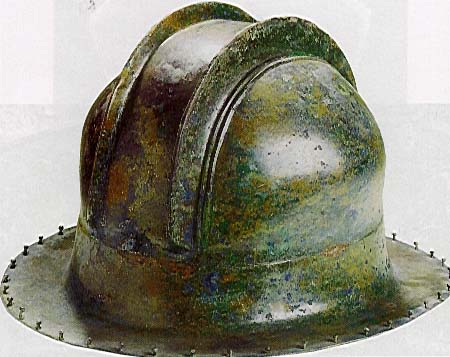
Hełm z Vače pochodzący z V wieku p.n.e. (Muzeum Przyrodnicze w Wiedniu)
***
Page 15
The Hallstatt Culture
The proliferation of the Hallstatt Culture, embracing the territory north of Eastern Alps to east Slovenia, is expressed mainly in ironwork. It received its name from the city of Hallstatt because of the numerous urn cemeteries there. The skill of the Veneti with handmade craft is seen in the three vessels from the 6th Century B.C. used for decorative and cultural purposes.
(Dolenjski Museum in Novo mesto)
***
Page 16
The Method of Burial
At the time of Hallstatt Culture in some locations, especially at Dolenjska we find many burials of skeletons, possibly because of the influence from the northwestern part of Hallstatt Culture where the Celts appeared. In any case, from this we cannot assume a change in the population, because Urn and skeleton burials appear at the same locations, either in level or in heaped graves.
Grave of a woman with rich jewelry from the 6th Century B. C. Near Stična
***
Page 17
Unchanged Ethnicity
The existence of the same population on present day Slovenian territory, including at the time of the Hallstatt Culture, is proven by the uninterrupted custom of Urn burials and with the use of the same language that is evident in the Venetic inscriptions, e.g. in the inscriptions on two vessels from a grave in Idria near Bače where the script on both is read from the left and from the right, and on the second from the right. For this reason it not possible to ignore the Slovenian meaning of the inscription. (See the book ‚Slovenci – kdo smo’, 188 -190).
(The Museum of Natural Science in Vienna)
Page 18
No Military Conquests
During the period of Hallstat Culture, we frequently find soldier’s equipment in graves that indicated the presence of greater danger and even possible conflicts. It is known that in the middle of the 6th Century B. C selected incursions of Skits to the Panonian plains occurred. However Skits did not settle in these parts. There is also no knowledge of other ethnic movements or conquest in the area of present day Slovenian territories.
Armor of a soldier from Stična dating from the 7th Century B. C.
(The National Museum of Slovenia in Ljubljana)
***
Strona 15
Kultura Hallstatt
Rozprzestrzenianie się kultury Hallstatt, obejmującej terytorium od północnych Alp Wschodnich do wschodniej Słowenii, wyraża się głównie w obróbce żelaza. Nazwa pochodzi od miasta Hallstatt ze względu na liczne istniejace tam cmentarze popielnicowe. Umiejętność Venedów w rzemiośle ręcznym widać na trzech statkach z VI wieku p.n.e. wykorzystywane do celów dekoracyjnych i kulturalnych.
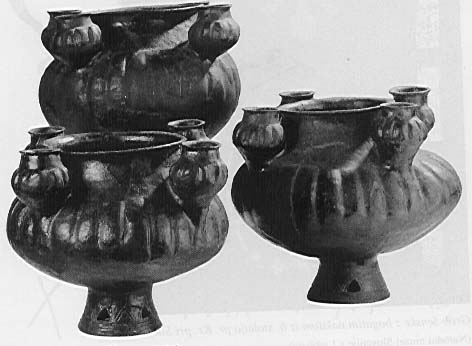
(Muzeum Dolenjski w Novo mesto)
***
Strona 16
Metoda pochówku
W czasach kultury Hallstatt w niektórych lokalizacjach, szczególnie w Dolenjska, znajdujemy wiele pochówków szkieletów, prawdopodobnie z powodu wpływów z północno-zachodniej części kultury Hallstatt, w której pojawili się Celtowie. W każdym razie z tego nie możemy założyć zmiany populacji, ponieważ pochówki popielnicowe i szkieletowe pojawiają się w tych samych miejscach, na powierzhni lub w grobowcach.
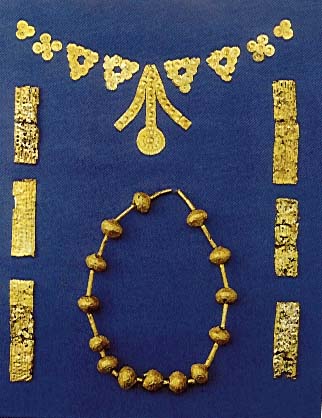
Grób kobiety z bogatą biżuterią z VI wieku pne. Blisko Stičny
***
Strona 17
Bez zmian etnicznych
O istnieniu tej samej populacji na dzisiejszym terytorium słoweńskim, w tym w czasach kultury Hallstatt, dowodzi nieprzerwany zwyczaj pochówków w popielnicach i opisy przy użyciu tego samego języka, który jest widoczny w inskrypcjach wenedzkich, np. w inskrypcjach na dwóch naczyniach z grobu w Idrii koło Bače, gdzie pismo na obu czytano z lewej i prawej strony, a na drugim z prawej strony. Z tego powodu nie można zignorować słoweńskiego znaczenia napisu. (Zobacz książkę „Slovenci – kdo smo”, str. 188–190).

(Muzeum Przyrodnicze w Wiedniu)
Strona 18
Żadnych podbojów wojskowych
W okresie kultury Hallstat często znajdujemy w grobach wyposażenie wojskowe, które wskazuje na zwiększenie niebezpieczeństwa, a nawet na możliwe konflikty. Wiadomo, że w połowie VI wieku pne dokonały się wtargnięcia w wybranych regionach Scytów na równiny panońskie. Jednak Scytowie nie osiedlili sie w tych regionach. Nie ma również wiedzy o innych ruchach etnicznych ani podbojach na terenie dzisiejszych terytoriów słoweńskich.

Zbroja żołnierza ze Stičny pochodząca z VII wieku B.
(Muzeum Narodowe Słowenii w Lublanie)
The Arrival of Celts
The Hallstatt Culture was partly replaced by the Tene Culture introduced by the Celt. This was the first invasion of both Venetic territory and ethnicity. However the Celts came to the Slovenian region relatively late, namely around 250 years B. C., during their return from Greece after being defeated by the Romans. When the Romans arrived in present day Slovenia, in the 1st Century B. C., there is no mention of the Celts. There are also very few remains of Celtic material culture. From all this it is obvious that they could not change the character of the region. This was not even their intention. Therefore it is totally unsubstantiated to hint of some kind of ‚Celtisized aborigines’ on Slovenian territory.
Dark violet = first Celt territories, light violet = areas of Celt settlement, green = present now
The map shows the areas that were settled by Celts, from 5th Century B. C. to the arrival of Romans
***
Page 20
Urnfield Burials Testify to Venetic Culture
Proof of uninterrupted Venetic population and their customs, also during the time of the Celtic presence, are the graves on Kapiteljska njiva (Fields) in Novo mesto where more then 600 Urn graves from the 3rd and the 2nd Century B. C. were found.
Biological continuity is not the only authoritative factor for the determination of national identity. The river remains the same despite the adding of other waters.
***
Page 21
Urns with cremated remains of the dead from the 2nd Century B. C. were found in graves at Kapiteljska njiva in Novo mesto that seem of Celtic nature due to added items. However urnfield burials in particular confirm the presence of Venetic Culture.
(Dolenski Museum in Novo mesto)
It is not valid evidence to attribute a certain origin or culture to the dead by items found and on the grounds of separate items in the grave. It is necessary to consider all the evidence.
(Ralph Pollath in his book ‘Slovenia in sosednje dežele med antiko in karolinško dobo – Začetki slovenske etnogeneze’, Page 1011)
***
Page 22
THE CULTURE OF ESTE
Specifics of Este Culture on Slovenian Territory
In the history of Veneti, the Este Culture plays a primary role. It concerns the continuation of the Urnfield Culture burials, but with a difference, where, in Este Culture the Veneti developed their script and left for their descendants the legacy of invaluable monuments with many inscriptions, mainly in Italy, where the center of the Este Culture was, but in addition also in Slovenia. The little city of Este (Ateste) is near Padova and it was a religious center and also a school for writers. The Venetic inscriptions are the greatest proof that Venetic language is of a Slovenian character.
The inscription from Idria near Bače
(Museum of Natural Science in Vienna)
***
Przybycie Celtów
Kultura Hallstatt została częściowo zastąpiona kulturą La Tene wprowadzoną przez Celtów. Była to pierwsza inwazja zarówno terytorium wenedzkiego, jak i pochodzenia etnicznego. Jednak Celtowie przybyli do regionu słoweńskiego stosunkowo późno, mianowicie około 250 lat p.n.e., podczas powrotu z Grecji po pokonaniu przez Rzymian. Kiedy Rzymianie przybyli do dzisiejszej Słowenii, w I wieku p.n.e., nie ma wzmianki o Celtach. Istnieje również bardzo niewiele pozostałości celtyckiej kultury materialnej. Z tego wszystkiego widać, że nie mogli zmienić charakteru regionu. To nie był nawet ich zamiar. Dlatego też całkowicie bezpodstawne jest wskazanie pewnego rodzaju „celtyckich aborygenów” na terytorium Słowenii.

Ciemnofioletowy = pierwsze terytoria Celtów, jasnofioletowy = obszary osadnictwa Celtów, zielony = współcześnie
Mapa pokazuje obszary zasiedlone przez Celtów, od V wieku pne do przybycia Rzymian
***
Strona 20
Pogrzeby na Polach popielnicowych świadczą o kulturze wenedzkiej
Dowodem niezakłóconej populacji wenedzkiej i ich zwyczajów, również w czasie celtyckiej obecności, są groby na Kapiteljska njiva (Pole) w Novo mesto, w których znaleziono ponad 600 grobów popielnicowych z III i II wieku pne.
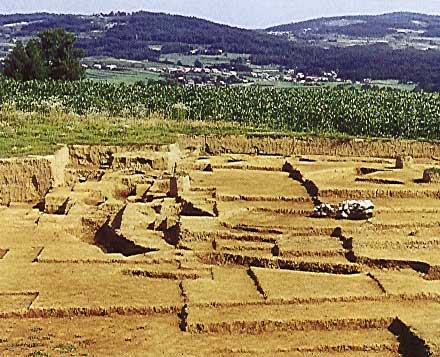
Ciągłość biologiczna nie jest jedynym autorytatywnym czynnikiem określającym tożsamość narodową. Rzeka pozostaje taka sama pomimo dodania innych wód.
***
Strona 21
Urny ze skremowanymi szczątkami zmarłych z II wieku pne zostały znalezione w grobach Kapiteljska njiva w Novo mesto, które wydają się mieć celtycką naturę z powodu dodanych przedmiotów. Jednak pochówki na polach w szczególności potwierdzają obecność kultury wenedzkiej.

(Muzeum Doleńskiego w Novo mesto)
Nie jest ważnym dowodem przypisywanie zmarłym określonego pochodzenia lub kultury przez znalezione przedmioty i na podstawie oddzielnych przedmiotów w grobie. Konieczne jest rozważenie wszystkich dowodów.
(Ralph Pollath w swojej książce „Słowenia in sosednje dežele med antiko in karolinško dobo – Začetki slovenske etnogeneze”, strona 1011)
***
Str. 22
KULTURA ESTE
Specyfika kultury Este na terytorium słoweńskim
W historii Wenedów podstawową rolę odgrywa Kultura Este. Dotyczy kontynuacji pochówków kultury pól popielnicowych, ale z tą różnicą, że w kulturze Este Wenedzi opracowali scenariusz i pozostawili potomkom dziedzictwo cennych zabytków z wieloma napisami, głównie we Włoszech, gdzie znajdowało się centrum kultury Este, ale także obejmowała Słowenię. Małe miasto Este (Ateste) znajduje się w pobliżu Padwy i było centrum religijnym, a także szkołą dla pisarzy. Napisy wenedzkie są najlepszym dowodem na to, że język wenedzki ma słoweński charakter.
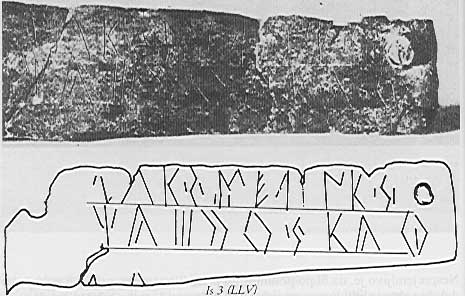
Napis z Idrii pod Bače
(Muzeum Przyrodnicze w Wiedniu)
***
Page 23
The Slovenian Center of Este Culture
Idria near Bače and Most na Soči (Sv. Lucija) was one of the prime centers of Venetic Este Culture, as is evident from the large number of graves. 6500 Urn graves found there, 1500 in Kobarid and 458 in Tolmin. The settlement Most na Soči had its graves on the other side of Idrijca river, on a large terrace. The Venetic scripts are from Idria near Bače.
| In the Early Iron Age the population of the settlement Most na Soči transported their dead across the river to the left of the river flow. On a large terrace on the left side of Ograjnica river was a large necropolis that was researched by archeologists from Triest and Vienna. 6500 graves were uncovered. |
Farm tools from Idria near Bače indicate an uninterrupted farming culture on the Slovenian territory. (Museum of Natural Science in Vienna)
***
(Museum of Natural Science in Vienna)
Farming tools from Idrija near Bače testify to un uninterupted farm culture in Slovenia.
Page 24
Extension of Este Culture
The Este Culture was spread over the whole of present day Slovenian territory and was interwoven with Hallstatt Culture. We must also attribute many situlas and other items in the style of situlas to Este Culture as well as Venetic inscriptions found from Škocjan na Krasu to Negova. One such item is the ciborium from Magdalenska gora near Šmarje from the 5th Century B. C.
(The National Museum of Slovenia in Ljubljana)
***
Page 25
The Inscription of Škocjan
OSTI JAREJ (Ostani mladenič = Stay Young)
A toast on the situla or jug from Škocjan na Krasu (on the Karst). Even though the inscription dates back more than 2000 years, it sounds very similar to modern Slovenian. ‘Osti’ means ‘Stay’, still ‘Ousti’ on the Karst to-day.
‘Jar’ is a well-known Slovenian word meaning ‘Young or New’. The noun form ‘jarej’ is still used in Charintian dialect.
***
Str. 23
Słoweńskie Centrum Kultury Este
Idria w pobliżu Bače i Most na Soči (Sv. Lucija) była jednym z głównych ośrodków kultury wenedzkiej Este, jak wynika z dużej liczby grobów. Znaleziono tam 6500 grobów popielnicowych, 1500 w Kobarid i 458 w Tolmin. Osada Most na Soči miała groby po drugiej stronie rzeki Idrijca, na dużym tarasie. Skrypty wenedzkie pochodzą z Idrii niedaleko Bače.
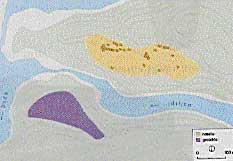
We wczesnej epoce żelaza ludność osady Most na Soči transportowała zmarłych przez rzekę na lewą stronę od rzeki. Na dużym tarasie po lewej stronie rzeki Ograjnica znajdowała się duża nekropolia, którą badali archeolodzy z Triestu i Wiednia. Odkryto 6500 grobów.
Narzędzia rolnicze z Idrii niedaleko Bače wskazują na nieprzerwaną kulturę rolniczą na terytorium Słowenii. (Muzeum Przyrodnicze w Wiedniu)
***
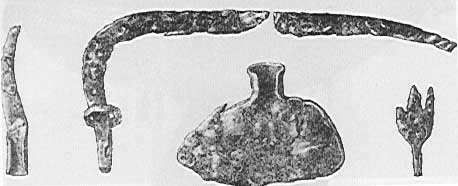
(Muzeum Przyrodnicze w Wiedniu)
Narzędzia rolnicze z Idriji niedaleko Bače świadczą o nieprzerwanej kulturze rolniczej w Słowenii.
Str. 24
Rozszerzenie kultury Este
Kultura Este rozprzestrzeniła się na całym dzisiejszym terytorium Słowenii i przeplatała się z kulturą Hallstatt. Musimy także przypisać wiele situl i innych przedmiotów w stylu situl kulturze Este, a także inskrypcje wenedzkie znalezione od Škocjan na Krasu do Negova. Jednym z takich przedmiotów jest cyborium z Magdalenyka gora niedaleko Šmarje z V wieku pne.
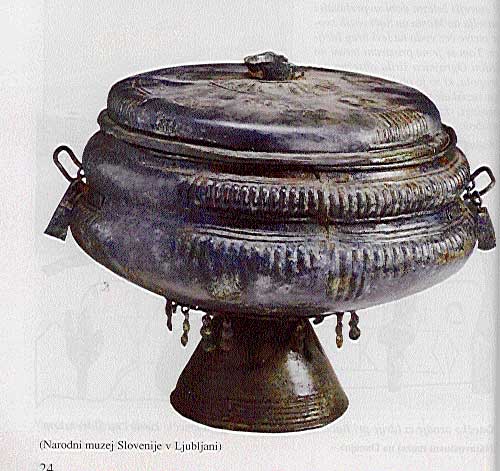 (Muzeum Narodowe Słowenii w Lublanie)
(Muzeum Narodowe Słowenii w Lublanie)
***
Str. 25
Napis ze Škocjan

OSTI JAREJ (Ostani mladenič = Pozostań Młody)
Ryt na sytuli lub dzbanku ze Skocjanu na Krasu (na Krasie). Choć napis pochodzi sprzed ponad 2000 lat, brzmi bardzo podobnie do współczesnego słoweńskiego. „Osti” oznacza „Zostań”, wciąż „Ousti” na Krasie.
„Jar” to znane słoweńskie słowo oznaczające „młody lub nowy”. Forma rzeczownika „jarej” jest nadal używana w dialekcie karantańskim.
***
